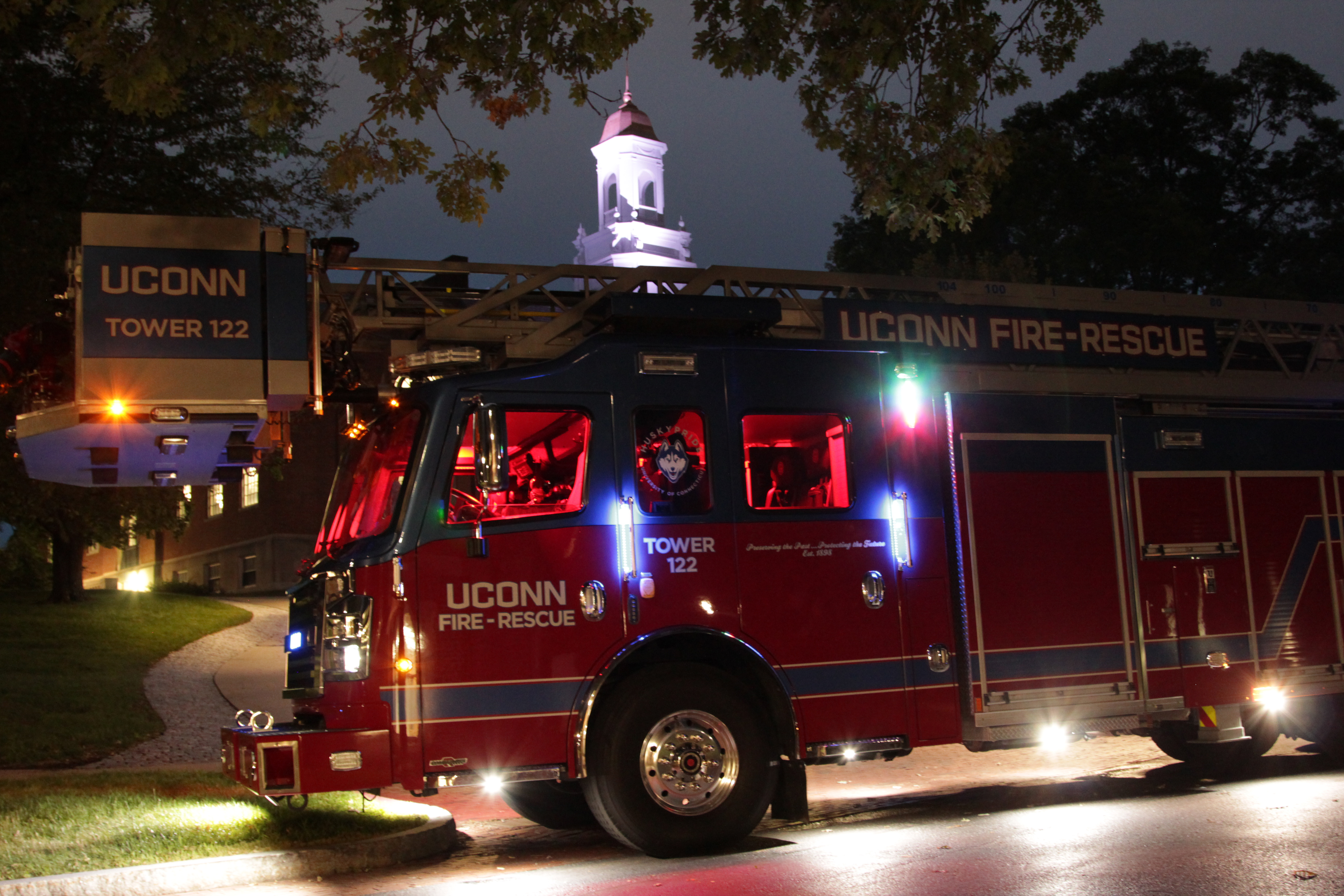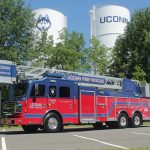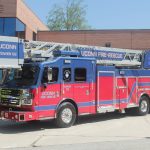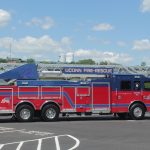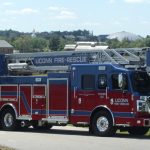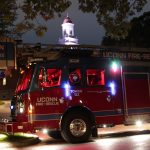The UConn Fire Department’s ability to handle difficult fires, emergencies in high places, and other complex rescue calls is now being greatly enhanced with the addition of a modern ladder truck to its firefighting apparatus.
The new Tower 122 truck was delivered to the University this spring, and went into service July 7 after the necessary practice runs were completed and firefighters were trained in its use. The new vehicle replaces the department’s 1994 truck, which had outlived its 20-year service life and was increasingly out of service in need of costly repairs.
“This purchase was planned out very thoughtfully to meet the needs of the University for another 20 years,” UConn Fire Chief Greg Priest says of the new Rosenbauer truck, which can carry 300 gallons of water in its on-board tank and, when attached to a hydrant, can pump 1,500 gallons per minute.
The purchase comes after a three-year planning process that started with a committee of people from the fire department, motor pool, and elsewhere, who mapped out the attributes a new truck would need to best serve the campus.
UConn Fire Capt. Mitchell Dlubac, an 18-year veteran of the department, headed the committee as it painstakingly reviewed everything from the ideal on-board generator power to the sizes and lengths of the hoses, the aerial’s maximum reach and angles, and other attributes.
Rosenbauer was selected through a competitive bidding process, making UConn one of a growing number of East Coast fire departments to add equipment from that company, which has been producing fire apparatus in Europe for more than a century. The vehicle was built and equipped entirely in the U.S., and replaces the Pierce that had been in service at Storrs since 1994.
Four additional feet might not sound like much, but it could get you to the next window. — Fire Chief Greg Priest
With a 104-foot height when extended, the new truck’s aerial is four feet longer than that of the previous truck, meaning its ladder can reach the highest levels of every residential building on campus, even the notably tall buildings such as the McMahon and Next Gen halls.
“Four additional feet might not sound like much, but it could get you to the next window,” Priest says, adding that there’s also another ladder at the end so people can climb on from windows or roofs without assistance, and can then get to the safety of the bucket even if the firefighters haven’t yet reached them.
The new truck is also slightly shorter in length than the old truck, which makes it much easier to maneuver around corners, near pedestrians and parked cars, and in the many other tight spots around the Storrs campus.
Dlubac says another attractive feature of the Rosenbauer is that its windshield and other replacement parts are not exclusive to that maker, so the University can save time and money by purchasing them from whichever company offers the best value. The last truck needed special replacement parts made only by that manufacturer, which meant the University couldn’t shop around for lower prices.
“This should provide long-term savings, and also help ensure the truck returns to service more quickly, which is a benefit to the University and to everyone that the department serves,” Dlubac says.
The tower truck’s price through competitive bidding was $1.2 million, which is in line with the industry standard for such vehicles. The University also received $50,000 for the trade-in value of the 23-year-old previous tower truck.
The new truck has already received positive reviews from people who’ve spotted it being driven around campus on test runs. Dlubac says many students have stopped to take photos with the truck, or to praise the integration of “UConn blue” and the Husky logo as part of the red truck’s exterior design.
Some of the new tower truck’s benefits are invisible, but profound.
For instance, better insulation in the vehicle’s cab means firefighters will be better able to hear each other and the radio, and less likely to experience the kind of hearing damage that can occur from close proximity to the loud sirens outside.
Some other features include a rear mounting for the aerial tower rather than mounting on the front of the truck, which means the bucket hangs off the front and visibility is better for the driver. The old vehicle had that feature, too, which made training on the new vehicle move along easily and quickly.
The aerial can also be maneuvered to lower its ladder and bucket below grade – a feature the old truck lacked – to help rescue people who may be stuck in low-lying areas due to car crashes, construction accidents, and other emergencies.
The Willimantic Fire Department is the only agency nearby that has a similarly large, well-equipped tower truck. However, it can take 20 minutes for that vehicle to get to campus in an emergency depending on road conditions, including the slower speed at which the heavy truck moves when traveling up Spring Hill on Route 195.
Because of UConn’s proximity to Storrs Center, the UConn Fire Department responds to emergencies at that commercial and residential complex, along with nearby neighborhoods. That means the new tower truck’s attributes benefit not only UConn, but also the Town of Mansfield.
“There are no other resources like this that are directly bordering the University,” Priest said of the new UConn vehicle. “A tower truck is a critical piece of life safety equipment, and when you need it there’s no way to get the desired result with a different type of apparatus.”
